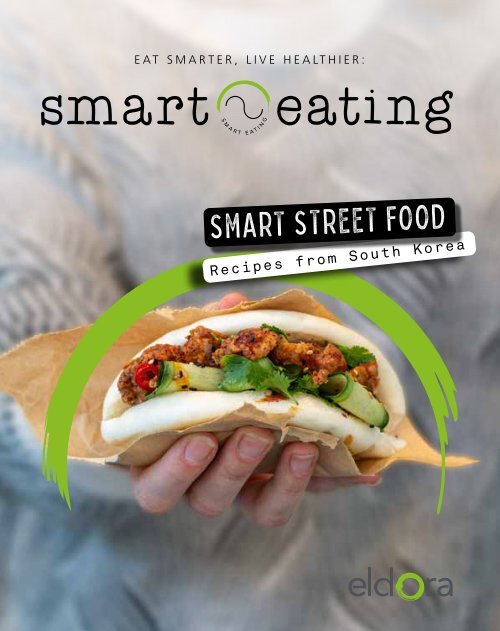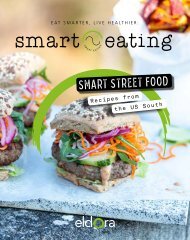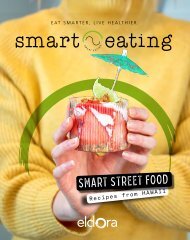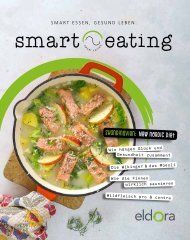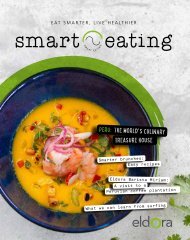Smart Eating Street Food Südkorea Englisch
In the fourth issue of Smart Eating, we focus on the topic of street food. Street food is often too greasy, too carbohydrate-heavy and has too little fibre. We have made it our mission to cook popular Korean street food in a healthy way.
In the fourth issue of Smart Eating, we focus on the topic of street food. Street food is often too greasy, too carbohydrate-heavy and has too little fibre. We have made it our mission to cook popular Korean street food in a healthy way.
You also want an ePaper? Increase the reach of your titles
YUMPU automatically turns print PDFs into web optimized ePapers that Google loves.
EAT SMARTER, LIVE HEALTHIER:<br />
SMART STREET FOOD<br />
Recipes from South Korea
2<br />
CONTENTS<br />
DEAR GUESTS,<br />
DEAR READERS,<br />
SMART EATING<br />
STREET FOOD RECIPES<br />
In 2019, we developed <strong>Smart</strong> <strong>Eating</strong> – a<br />
concept for healthy nutrition that not only<br />
looks great but also tastes delicious. And it<br />
seems we're on to something. In 2020, we<br />
So we got to work tinkering with the recipes<br />
in order to make “SMART" versions of pop-<br />
4 >> The three pillars of a<br />
"smart" life<br />
6 >> The "<strong>Smart</strong> <strong>Eating</strong>" formula<br />
26 >> Chicken bao<br />
30 >> Bibimbap<br />
32 >> Stir-fry<br />
received the Gold Marketing Award for<br />
Communal Catering (German-speaking Europe)<br />
for <strong>Smart</strong> <strong>Eating</strong>. For this year, we<br />
have taken this concept one step further. In<br />
ular street food dishes. Our journey begins<br />
in South Korea before continuing on to Hawaii<br />
and ending in the American South. We<br />
are pleased to present you with the results<br />
8 >> STREET FOOD<br />
12 >> <strong>Street</strong> food facts<br />
TIME TO relax<br />
34 >> Jjimjilbang<br />
2023, our theme will be street food and<br />
of our in-depth research and delicious trial<br />
showing that it can absolutely be prepared<br />
in a healthy way. For this purpose, we have<br />
set off on a culinary journey around the<br />
world and have been inspired by a variety of<br />
different cultures and cuisines. Ever since<br />
annual street food festivals began to pop up<br />
and error in the kitchen in the form of recipes<br />
in this magazine and dishes cooked in<br />
our restaurants, available on our special<br />
theme days.<br />
We hope you'll stop by!<br />
14 >> WELCOME TO SOUTH KOREA<br />
20 >> Korean cuisine<br />
22 >> Kimchi<br />
24 >> Korean street food<br />
SALAD RECIPES<br />
38 >> Japchae glass noodle salad<br />
39 >> Cabbage salad with egg<br />
40 >> Ssambap<br />
in cities around the country, many previously<br />
unknown dishes have become popular and<br />
TIME TO move<br />
well known here in Switzerland. However,<br />
oftentimes these dishes aren't very healthy<br />
Christian Hürlimann<br />
42 >> Taekwondo<br />
or balanced: too many carbohydrates, too<br />
COO Business Catering<br />
much fat, too little fibre.<br />
44
4 5<br />
Relaxation<br />
Exercise<br />
Nutrition, exercise and relaxation are<br />
building blocks for a<br />
healthy, vital life.<br />
Nutrition<br />
<strong>Smart</strong> <strong>Eating</strong><br />
Nutrition is an extremely personal<br />
topic. Very few of us are<br />
willing to subject ourselves to<br />
restrictive rules and limitations<br />
over the long term. Instead, we<br />
Live smart<br />
>> Finding the right mix of nutrition,<br />
exercise and relaxation so that<br />
you feel good and stay happy and<br />
healthy.<br />
make more and more "tiny exceptions"<br />
from the latest hyped<br />
health trend until we finally give<br />
>> Seeing health as a form of<br />
self-respect, not self-regulation.<br />
up on all our good intentions and<br />
end up right back where we<br />
started.<br />
>> Not cutting out anything that<br />
makes you truly happy – after<br />
all, it's not sustainable.<br />
Many years ago, we began thinking<br />
about how to break this cycle.<br />
Certainly not with another new<br />
>> Making healthy nutrition,<br />
exercise and relaxation enjoyable.<br />
diet. Quite the opposite: Eldora<br />
developed "<strong>Smart</strong> <strong>Eating</strong>" in response<br />
to all the fad diets and<br />
>> Striving for a healthy balance that is<br />
realistically<br />
the concept of restriction, of-<br />
achievable in the long term.<br />
fering instead a nutritional approach<br />
focussed on enjoyment.<br />
"<strong>Smart</strong> <strong>Eating</strong>" makes healthy eat-<br />
>> Mindfully observing what is<br />
happening in one's mind<br />
ing sexy!<br />
and body.
7<br />
You have probably seen<br />
this logo at your<br />
Eldora restaurant.<br />
It represents Eldora's own<br />
healthy eating concept.<br />
Some restaurants offer<br />
"<strong>Smart</strong> <strong>Eating</strong>" as a daily<br />
menu line, others highlight<br />
certain "<strong>Smart</strong> <strong>Eating</strong>" dishes<br />
on the menu or particularly<br />
healthy products in the<br />
snacking section.<br />
We are NOW expanding this<br />
nutritional concept as a<br />
special promotion. At the<br />
same time, we have also<br />
published this magazine in<br />
which we address topics<br />
such as nutrition, exercise<br />
and relaxation.<br />
"<strong>Smart</strong> <strong>Eating</strong>" makes<br />
healthy eating sexy.<br />
"<strong>Smart</strong> <strong>Eating</strong>" is sexy.<br />
>> The dishes look great, feature creative<br />
combinations of colours and flavours, bring the<br />
best products to your plate and simply taste<br />
delicious!<br />
"<strong>Smart</strong> <strong>Eating</strong>" makes you sexy.<br />
>> Good food = good mood! Light dishes keep<br />
you feeling fit throughout the day and give<br />
you lots of energy. This puts you in a good<br />
mood and gives you a sexy aura!<br />
"<strong>Smart</strong> <strong>Eating</strong>" is simple.<br />
>> You no longer need to ask what and how<br />
much you "should" eat for lunch. Counting<br />
calories is also a thing of the past. We offer you<br />
the perfect, healthy meal.<br />
>> "<strong>Smart</strong> <strong>Eating</strong>" dishes are designed for<br />
individuals who work sedentary jobs. They keep<br />
you satisfied and give you power.<br />
>> You can also look for the logo in Eldora's<br />
range of snacks and extras.<br />
"<strong>Smart</strong> <strong>Eating</strong>"<br />
is healthy.<br />
>> "<strong>Smart</strong> <strong>Eating</strong>" dishes contain<br />
just 500 to a maximum of 600<br />
calories.<br />
>> "<strong>Smart</strong> <strong>Eating</strong>" meals contain<br />
everything your body needs.<br />
No more, no less. But, most importantly:<br />
the RIGHT STUFF – namely a<br />
balanced and fresh diet.<br />
>> We use products with high nutritional<br />
value. The dishes are rich in vitamins and<br />
minerals and high in fibre.<br />
>> Instead of using lots of salt, we season our<br />
food with fresh herbs. We use natural sweeteners<br />
like Stevia instead of refined sugars.<br />
>> Each dish contains only 15 grams of fat,<br />
equivalent to one tablespoon.<br />
>> We take plenty of time to prepare the<br />
dishes using especially gentle cooking methods and<br />
choose methods of preparation that offer<br />
maximum flavour without a lot of added fat.<br />
"<strong>Smart</strong><br />
<strong>Eating</strong>"<br />
is not a<br />
diet!<br />
50%<br />
VEGETABLES, SALAD,<br />
FRUIT<br />
We know what we're doing.<br />
>> We have many years of experience with different<br />
nutritional concepts that we have introduced<br />
for our customers.<br />
>> "<strong>Smart</strong> <strong>Eating</strong>" is based on the Swiss food<br />
pyramid and follows the guidelines of the Swiss<br />
Society of Nutrition.<br />
25%<br />
PROTEIN, plant-<br />
or animal-based<br />
25%<br />
CARBOHYDRATES
8 9<br />
In many parts of the world, street restaurants and<br />
street kitchens have been part of the cultural<br />
landscape for thousands of years. Naturally (or<br />
fortunately), the dishes they serve have evolved<br />
over time. What has remained, however, is a passion<br />
for delicious foods served hot, fresh and fast.<br />
From hot dogs and corn on the cob to Currywurst<br />
and Magenbrot all the way to satay<br />
skewers or even more unusual foods like<br />
grilled insects or chicken feet: no matter<br />
where you are in the world, there will be<br />
street food. And that's been the case for<br />
quite some time.<br />
WHO INVENTED STREET FOOD?<br />
More than 6,000 years ago, the Ancient Egyptians<br />
grilled fish on the street and sold it. The<br />
Ancient Greeks adopted the Egyptians' eating<br />
habits, and the Ancient Romans would go on<br />
to perfect street kitchens. They sold ready-toeat<br />
foods out of a window onto the street<br />
from shops that were called thermopolium<br />
(Greek for "a place where something hot is<br />
sold"). At the thermopolium, staple foods like<br />
spelt stew, legumes, and meat were sold to<br />
the poorer Roman citizens. After all, only the<br />
rich could afford their own kitchens at that<br />
time. In China (from 700 B.C.), street food<br />
had long been something for the destitute.<br />
Nevertheless, the street food was popular,<br />
and the rich and powerful would send couriers<br />
out to buy it for them – a precursor to<br />
today's food delivery services.
10 11<br />
STREET FOOD FACTS<br />
The country with the most<br />
street food stands...<br />
10 million<br />
...with over 10 million is: India! But<br />
Thailand is also a front-runner. Bangkok<br />
alone is home to 300,000 street<br />
kitchens, making it the top city for<br />
street food.<br />
The most expensive street food...<br />
...is a taco. For USD 25,000, you<br />
can have one in Mexico. It contains<br />
Kobe beef, Beluga caviar,<br />
The world's most<br />
popular street food...<br />
langoustine, black truffle brie and<br />
gold leaf. In comparison, at just<br />
USD 2,700, the world's most expensive<br />
pizza is practically a bargain!<br />
...is roti canai, according to a<br />
TravelAtlas survey. Roti canai is<br />
300,000<br />
buttery flatbread from Malaysia that<br />
is eaten for breakfast with different<br />
curries.<br />
FROM PEASANT FOOD TO BEST-<br />
SELLER<br />
In the Middle Ages, street kitchens once again<br />
sold "peasant food". In Paris, pâté originated<br />
in the 14th century. It was made up of meat<br />
and vegetables that were wrapped in pastry,<br />
thus keeping them fresh for longer. Pâtés<br />
served as the basis for many well-known<br />
dishes today, such as English pies and pasties,<br />
empanadas, and many sweet pastries. But<br />
pâté is not the only success story that travelled<br />
around the world; fried fish is another<br />
excellent example. Jewish immigrants brought<br />
the practice of battering and frying fish to<br />
English. Because they were not allowed to<br />
cook on the Sabbath, they would dip their<br />
fish in batter and fry it on Fridays. This way,<br />
they could eat it cold on Saturdays. The first<br />
"chippy" opened in London in 1860. Unfortunately,<br />
today it is not entirely clear where the<br />
chips in "fish and chips" originated. Presumably<br />
they come from the French-speaking part<br />
of Belgium. American Soldiers brought them<br />
back home from the WWII and since people in<br />
Belgium spoke French they became known as<br />
French Fries.<br />
STREET FOOD IN SWITZERLAND<br />
What's the most common street food in Switzerland?<br />
Bratwurst (or cervelat) with or without<br />
mustard, what else! Of course, it wouldn't<br />
be autumn in Switzerland without roasted<br />
chestnuts, Magenbrot and other sweets. Nevertheless,<br />
sausage more than any other food<br />
has a special place in our hearts. Why is that?<br />
Sausage-making is the oldest form of meat<br />
preservation, and was therefore ideal for large<br />
outdoor fairs where there was no refrigeration.<br />
And we all love fairs! Therefore, it's no<br />
surprise that there are more than 400 types of<br />
sausage in Switzerland, and just as many sausage-related<br />
figures of speech.<br />
Taco photo: Grand Velas Los Cabos
12 13<br />
WORLD<br />
Fish && Chips<br />
POUTINE<br />
Msemmen<br />
tamales<br />
dONUTs<br />
BEIGNETS<br />
Vada Pao Pao<br />
bao Buns<br />
Recipe P. P. 26 26<br />
Shucos<br />
arepas<br />
Mie Mie goreng<br />
ANTICUCHOS<br />
Coxinha<br />
BILTONG<br />
Pigs in in Blanket<br />
EMPANADAs
14 15<br />
안녕<br />
ANNYEONG<br />
SOUTH KOREA<br />
7.32 pm,<br />
Gwangjang Market, Seoul.<br />
The famous centuries-old Gwangjang<br />
Market in the capital of<br />
South Korea is filled with<br />
countless food stands, each<br />
selling freshly prepared dishes<br />
such as kimpab (Korean sushi<br />
rolls), tteok-bokki (rice cakes<br />
in a spicy sauce) and eumok<br />
(fish cake on a skewer).
16 17<br />
THE LAND OF THE MORNING CALM...<br />
Before the sun reaches mainland Asia, it first<br />
rises over South Korea, bathing the foggy mountains<br />
and the green landscape in a warm, golden<br />
light. In South Korea, only 8% of the population<br />
lives outside of the large cities. Accordingly,<br />
much of the countryside is uninhabited and is, in<br />
fact, truly serene – and not only in the morning.<br />
... OF THE FAST-<br />
PACED...<br />
The cities are a whole different story, however.<br />
Many South Koreans live according to<br />
the motto: As much as possible, as quickly<br />
as possible. Everything needs to happen<br />
quickly, or "ppalli ppalli" in Korean (English:<br />
"fast fast"). This applies to day-to-day business,<br />
the private sphere, and food. That's<br />
why there are food stands and large markets<br />
on practically every corner where you can<br />
grab a cheap bite at any time, day or night.<br />
Very few people cook at home. Thanks to<br />
this fast pace, new homes, streets and even<br />
new technologies are popping up in South<br />
Korea in record time.<br />
... AND OF AMBITION.<br />
South Koreans learn early on: If you want to<br />
succeed, you have to work hard. Starting in<br />
primary school, competition among students<br />
is encouraged. At the office, people are at<br />
their desks from morning to night. Ordering<br />
food to be delivered right to your desk? Totally<br />
normal. Even everyday life is characterized<br />
by this almost overzealous drive for success.<br />
A casual hike without top gear?<br />
Impossible! And, of course, the goal is to<br />
reach the top as quickly as possible.
18 19<br />
South Korea is a country<br />
of contrasts. A place<br />
where massive metropolises<br />
are separated by<br />
rolling green hills, and<br />
where state-of-the-art<br />
technology meets a traditional,<br />
hierarchical<br />
culture.<br />
Seoul -– The Soul of Asia<br />
Seoul, the megacity with a population of<br />
just under ten million, is home to a cuisine<br />
that has been shaped by international<br />
influences. Primarily<br />
by Japan and the US. In addition<br />
to its culture and its many attractions,<br />
Seoul is also known for its hospitality.<br />
The city also has much to offer nature lovers:<br />
four large and several smaller mountains<br />
in and around the sprawling city, fantastic<br />
parks, and bicycle paths along the river are<br />
all excellent destinations for day trips and<br />
the perfect way to relax and get away from<br />
the hustle and bustle of everyday life. And,<br />
last but not least, it also promises a wonderful<br />
balance between delicious traditional<br />
and modern food.<br />
Seoul<br />
Gwangju<br />
Songnisan<br />
Nationalpark<br />
<strong>Südkorea</strong><br />
Busan<br />
POPULATION<br />
51.7 million<br />
SIZE<br />
2.4× Switzerland<br />
CAPITALSeoul<br />
HELLO/GOODBYEannyeong<br />
I'M HUNGRY.baegopayo<br />
THANK YOUgamsahaeyo<br />
I WILL EAT WELL.<br />
(TRADITIONAL SAYING INSTEAD OF<br />
"BON APPETIT")<br />
<br />
jal meokgetseumnida<br />
FUN FACTS<br />
• In Korea, on the day of your<br />
birth you're considered to be one<br />
year old.<br />
• Always address Koreans with the<br />
proper title and never with their<br />
first name.<br />
• Korean buildings never have a<br />
fourth storey. Four is an unlucky<br />
number.
20 21<br />
KOREAN CUISINE<br />
It is known as one of the world's most diverse and<br />
delicious cuisines – and rightly so. And yet here<br />
in Switzerland, East Asian cuisine is still practically<br />
unknown. Time for this to change.<br />
Traditional Korean cuisine is based on cooked rice and involves lots<br />
of vegetables, fish, broths and legumes. Koreans are particularly<br />
crazy about vegetables. They are prepared and served in countless<br />
ways and are a vital component of every meal. Red meat is only<br />
eaten in small quantities. This balance, which is often reflected in a<br />
single dish, is what makes the Korean diet one of the healthiest.<br />
Sesame oil<br />
Mirin (rice wine)<br />
Spring onions<br />
Rice vinegar<br />
Soy sauce<br />
Chili paste<br />
Primary ingredients in<br />
Korean cuisine<br />
Ginger<br />
Chilli<br />
METAL<br />
Spicy<br />
Lungs,<br />
large intestine<br />
Fire<br />
Bitter<br />
Heart,<br />
small<br />
intestine<br />
5<br />
Elements<br />
& Colours<br />
WAtER<br />
Salty<br />
Lorem ipsum<br />
Kidney,<br />
bladder<br />
Earth<br />
Sweet<br />
spleen,<br />
stomach<br />
Wood<br />
Sour<br />
Liver,<br />
gall<br />
In a Korean kitchen, you'll find many ingredients<br />
that also have medicinal properties,<br />
such as ginseng or bellflower root. And with<br />
good reason. For many people in Korea,<br />
food is naturally an important factor when it<br />
comes to their physical and mental health.<br />
Most people take care to make sure that<br />
they get all of their required nutrients every<br />
day.<br />
Bibimbap – arguably the<br />
best-known Korean dish –<br />
embodies everything that<br />
makes Korean cuisine so<br />
special: a wide range of<br />
different ingredients that<br />
combine flavour, harmony,<br />
variety and balance.<br />
THE KOREAN PHILOSOPHY<br />
OF FOOD<br />
The concept of harmony and balance is integral<br />
to both Korean culture and Korean cuisine.<br />
Many dishes are built around the philosophy<br />
of yin and yang, as well as the<br />
elements of wood, fire, earth, water and<br />
metal. Colours and organs have been assigned<br />
to each of the five elements. For a<br />
healthy diet, all colours and flavours (sour,<br />
bitter, spicy, etc.) should be represented as<br />
harmoniously as possible on one's plate.<br />
"<strong>Food</strong> and medicine<br />
share the same roots"<br />
Korean proverb
22 23<br />
KIMCHI<br />
KOREAN SUPERFOOD<br />
Kimchi is something of a symbol of<br />
Korean culture. That's because it<br />
perfectly encapsulates the importance<br />
of healthy eating and careful preparation.<br />
A meal without kimchi?<br />
Unimaginable.<br />
It is probably the best-known dish that has made the jump to the<br />
West: fermented napa cabbage (and sometimes radishes or cucumbers)<br />
flavoured with chilli, ginger and garlic. Nearly every Korean<br />
family has their own closely guarded kimchi recipe.<br />
Kimchi has a very unique taste; for Europeans, it often takes some<br />
getting used to. Much like sauerkraut would probably be for<br />
someone from Asia. This unique flavour is the result of fermentation.<br />
If you store food in a sealed container under anaerobic<br />
conditions, over time enzymes will change the food and allow lactic<br />
acid bacteria to develop. This is the acidity that we taste when we<br />
eat fermented foods like kimchi and sauerkraut. In Korea, this<br />
process goes back more than 2,000 years. Back then, however,<br />
people were not aware of the health benefits of fermentation.<br />
These lactic acid bacteria are extremely important for gut health<br />
and strengthen our natural immune defences. Vitamins C and B are<br />
also produced as a result of fermentation.
24 25<br />
Takoyaki<br />
Sharing a meal is an impor-<br />
Bungeo-ppang<br />
A fish-shaped<br />
filled pastry<br />
Mandu<br />
Kimbap<br />
Korean-style<br />
sushi rolls<br />
Dough balls<br />
with octopus<br />
Eumok/odeng<br />
Fish cakes in<br />
hot broth<br />
tant part of Korean culture.<br />
Typical Korean meals involve<br />
lots of small side dishes<br />
that are shared by everyone<br />
at the table. A major bonus<br />
for everyone with a big<br />
appetite: restaurants replenish<br />
these dishes for<br />
free! So you're sure to have<br />
plenty to eat.<br />
Dumplings<br />
with various<br />
fillings<br />
Bulgogi<br />
Beef grilled<br />
over an open<br />
Gamja hot dog<br />
flame<br />
A corn dog with<br />
french fries in<br />
the batter<br />
Gyeran-ppang<br />
Pancake bread<br />
with egg<br />
Bindae-tteok<br />
Mung bean pancake<br />
(sweet or salty)<br />
Tteok-kkochi<br />
Rice cakes<br />
in spicy<br />
sauce<br />
In addition to many traditional dishes such as<br />
kimchi, kimbap and soups, street markets<br />
also sell all kinds of fried food and junk food.<br />
These dishes are the result of the influence<br />
exerted by the kings of fried food: the Americans.<br />
Dishes like the gamja hot dog, Korean<br />
fried chicken and Korean donuts are more<br />
On the following pages, we will show you<br />
what healthy street food can look like.<br />
popular than ever.
26 27<br />
Chicken bao<br />
치킨 바오<br />
makes 4 servings<br />
CRISPY CHICKEN BAO:<br />
• 4 boneless, skinless chicken<br />
thighs (approx. 400 g)<br />
• 2 tbsp Swiss rapeseed oil<br />
• 1/2 cucumber<br />
• A handful of coriander,<br />
roughly chopped<br />
• 4 bao buns (for recipe,<br />
see next page)<br />
• White and black sesame<br />
seeds<br />
Marinade<br />
• 200 ml buttermilk<br />
• approx. 2 cm ginger<br />
• 1 clove of garlic<br />
Coating<br />
• 150 g white flour<br />
• Chili flakes<br />
• 1 tbsp baking powder<br />
• 2 sprigs fresh thyme<br />
• Salt, pepper, paprika<br />
COLOURFUL RED CABBAGE SALAD<br />
• 1/4 red cabbage<br />
• 1 carrot<br />
• 1 spring onion<br />
• 1 small pc. ginger<br />
• 2 tbsp rice vinegar<br />
• 1 tbsp organic agave syrup<br />
• 1 tbsp sesame oil<br />
›Peel the garlic and the ginger for<br />
the crispy chicken and the sauce<br />
and crush both with a garlic press.<br />
Add half to the buttermilk. Season<br />
with salt and pepper and marinate the<br />
chicken in the buttermilk for at least 4<br />
hours (or better, overnight).<br />
Chop the vegetables for the cabbage<br />
salad into thin strips and chop the spring<br />
onions into rings. Peel and purée the<br />
ginger (or crush with a garlic press).<br />
Combine all of the ingredients for the<br />
salad.<br />
GOCHUJANG SAUCE:<br />
• 2 tbsp gochujang paste<br />
• 2 tbsp rice vinegar<br />
• 3 tbsp honey<br />
• 6 tbsp organic soya sauce<br />
• 1 clove garlic<br />
• approx. 2 cm ginger<br />
• 1 tbsp sesame oil<br />
Combine the ingredients for the coating.<br />
Remove the chicken from the<br />
marinade, dredge it in the coating,<br />
then fry it in the rapeseed oil over high<br />
heat until golden brown. Finish the<br />
chicken thighs by baking them in an<br />
oven at 180°C (fan) for around 10<br />
minutes. » See next page
28 29<br />
Bao buns<br />
makes 4 pcs<br />
» Cont'd from page 26<br />
›Heat the sesame oil for the sauce.<br />
Briefly sauté the rest of the garlic-and-ginger<br />
mixture, remove it from the<br />
heat, add the rest of the ingredients and stir<br />
well to combine.<br />
Steam the buns in a metal or bamboo<br />
steamer for a few minutes.<br />
Peel the cucumber into long, thin strips with<br />
a vegetable peeler. Toast the sesame seeds<br />
briefly in a dry pan. Shortly before serving,<br />
coat the chicken thighs with the gochujang<br />
sauce, then fill the buns with the chicken as<br />
well as the coriander and cucumber. Sprinkle<br />
with the sesame seeds and serve with the cabbage<br />
salad.<br />
• 8 g fresh yeast or 1/2 sachet<br />
instant yeast<br />
• 60 ml cow's milk or plant milk<br />
• A pinch of sugar<br />
• 200 g fine white flour<br />
• 1–2 tbsp rapeseed oil<br />
›<br />
Dissolve the yeast in 10 ml warm water.<br />
Combine the yeast mixture with the<br />
milk and sugar in a bowl. Add the flour, 2<br />
tsp salt and the oil. Knead with an electric<br />
mixer (or by hand) to create a smooth dough.<br />
Cover dough with a damp cloth and let it<br />
rise in a warm spot for around one hour.
30 31<br />
Bibimbap<br />
비빔밥<br />
MAKES 4 SERVINGS<br />
• Fresh ginger, grated<br />
• 4 cloves of garlic<br />
• 300 g organic tofu<br />
• 60 ml organic soya sauce<br />
• White rice vinegar<br />
• Sesame oil, rapeseed oil<br />
• 1/2 onion, diced<br />
• 500 g fresh spinach<br />
• 1/2 small green papaya<br />
• 1 tbsp organic agave syrup<br />
• 3 carrots<br />
• 500 g shirataki noodles<br />
• 4 eggs<br />
GOCHUJANG SAUCE<br />
• 2 tbsp gochujang paste (available<br />
at Asian supermarkets)<br />
• 2 tbsp white rice vinegar<br />
• 3 tbsp honey<br />
• 6 tbsp organic soya sauce<br />
GARNISH<br />
• A handful of mung bean sprouts<br />
and coriander<br />
• 1/2 red chilli pepper<br />
• Black sesame seeds<br />
›Finely grate a 4–5 cm piece of ginger.<br />
Toast the sesame seeds in a dry pan. Remove<br />
the seeds from the red chilli pepper and<br />
slice into rings. Finely chop the garlic and cut<br />
the tofu into cubes. Combine the soya sauce,<br />
3 tbsp rice vinegar, and 1/2 tsp of both the ginger<br />
and the garlic. Marinate the tofu in this<br />
mixture overnight.<br />
Peel the green papaya, cut it in half, scoop<br />
out the seeds and grate on the coarse side of<br />
the grater. Combine 2 tbsp rice vinegar with<br />
the agave syrup and 1/2 tsp of the grated ginger.<br />
Combine the sauce with the papaya and<br />
season with salt.<br />
Chop the carrots into small pieces and toss<br />
with some sesame oil, salt and pepper. Tip the<br />
marinated tofu and the carrots onto a baking<br />
tin and bake at 165°C for 10–15 minutes.<br />
For the sauce, heat some sesame oil and<br />
briefly sauté around 1 tsp garlic and the rest<br />
of the ginger. Combine with the other sauce<br />
ingredients.<br />
Sauté the onions and the rest of the garlic in<br />
some rapeseed oil, add the spinach and let it<br />
cook down.<br />
Briefly heat the noodles in hot water (can<br />
also be eaten cold) and season them with sesame<br />
oil and salt. Heat some rapeseed oil in a<br />
pan, carefully crack the eggs into the pan and<br />
fry them. Season the fried eggs with salt and<br />
pepper. Roughly chop the coriander. Combine<br />
all of the ingredients in a bowl, sprinkle the<br />
sauce over the top, and garnish with mung<br />
bean sprouts, sesame seeds, coriander and<br />
red chilli pepper.
32 33<br />
Stir-fry<br />
with rice and vegan mince<br />
밥 볶음<br />
• 250 g plant-based mince<br />
• 1/2 red chilli pepper<br />
• 1/4 napa cabbage, broccoli<br />
• 120 g shiitake mushrooms<br />
• 1 onion<br />
• 1 small pc. ginger<br />
• 1/2 red chilli pepper<br />
• 180 g brown rice<br />
• 400 ml vegetable broth<br />
• 1 bay leaf<br />
• Rapeseed oil, sesame oil<br />
SAUCE<br />
• 8 tbsp organic soya sauce<br />
• 4 tbsp tomato ketchup<br />
• 5 tbsp rice wine<br />
• 2 tbsp maple syrup<br />
GARNISH<br />
• A handful of mung bean<br />
sprouts and coriander<br />
• 1 tbsp white and black<br />
sesame seeds<br />
›Combine all the ingredients for the sauce and mix well. Chop the vegetables<br />
and the shiitake mushrooms as desired. Peel the onion, ginger and<br />
garlic and finely chop along with the red chilli pepper. Rinse the brown rice<br />
twice with cold water. Sauté half the onion in some rapeseed oil. Add the<br />
brown rice, sauté until translucent, then add the hot vegetable broth, bring to<br />
the boil, and add the bay leaf. Simmer the rice over a low heat. Sauté the<br />
plant-based mince and the other half of the onion in sesame oil. Add the<br />
shiitake mushrooms, vegetables, ginger, half of the chilli pepper and the garlic<br />
and sauté briefly. Add the sauce and cook until the sauce thickens slightly.<br />
Season with pepper. Roughly chop the coriander and toast the sesame seeds in<br />
a dry pan for one to two minutes. Divide the rice up into four bowls, top with<br />
the stir-fry. Garnish with the coriander, mung bean sprouts, sesame seeds and<br />
the rest of the chilli pepper to taste.
35<br />
JJIMJILBANG<br />
RELAXING KOREAN-STYLE<br />
While the word may be hard to pronounce, the concept<br />
is easy to love. A jjimjilbang is a Korean<br />
bathhouse. It's something of a mixture between a<br />
Turkish hammam, a Finnish sauna, and Japanese onsen<br />
(hot springs). And since Koreans are never ones for<br />
half measures, a trip to a Korean bathhouse is an<br />
unforgettable experience.<br />
relax<br />
TIME TO<br />
In contrast to the hectic pace of everyday life,<br />
the ritual of bathing in Korea is properly celebrated.<br />
In these special bathhouses, there is a<br />
very specific order for treatments: you start in<br />
the hot tub or hot springs, allow yourself to be<br />
washed and scrubbed, then enjoy the steam<br />
baths and saunas. Unlike Finnish saunas, Korean<br />
saunas are not made of wood, but rather<br />
can be made of a variety of materials. For example,<br />
there are jade saunas (as pictured on<br />
the right), clay saunas, stone saunas and salt<br />
saunas. All are heated to different temperatures<br />
and promise a different healing effect.<br />
And, since bathing and steaming can work up<br />
an appetite, the bathhouses often have their<br />
own restaurants where people eat between<br />
treatments. Some even have cinemas, arcades<br />
or karaoke parlours for a bit of entertainment.<br />
Most bathhouses are open 24 hours a day,<br />
and many people choose to spend the night<br />
there. Yes, correct you can sleep there too.<br />
Night-time entry costs a maximum of CHF 10,<br />
which is much cheaper than a taxi ride home.<br />
You're not really friends until you've<br />
visited a jjimjilbang together.<br />
Korean proverb<br />
On the volcanic island of<br />
Jeju, south of the Korean<br />
Peninsula, there are sand<br />
saunas. Visitors can bury<br />
themselves in the sand on<br />
the beaches and enjoy the<br />
natural volcanic warmth.<br />
Images: Dragon Hill Spa, earthmaho.
36 37<br />
Korean salads<br />
Recipes on the next page<br />
Cabbage salad with<br />
pickled eggs and<br />
peanuts<br />
Koreans love eggs – hardboiled eggs<br />
as a snack on the go, during a<br />
break at work, or even in the sauna.<br />
Wait a minute – IN the sauna?<br />
Yes! In fact, they not only eat<br />
hardboiled eggs in the sauna, but<br />
they cook them there directly on<br />
the hot stones. For three whole<br />
hours! Well, that must smell...<br />
Nevertheless, maekbanseok gyeran<br />
(maekbanseok = elvan stone, gyeran<br />
= egg) are the most popular snack<br />
at jjimjilbangs.<br />
JAPCHAE<br />
Glass noodle salad with<br />
vegetables and mushrooms
38 39<br />
Japchae<br />
Glass noodle salad with vegetables<br />
• 5 tbsp organic soya sauce<br />
• 2 tbsp organic agave syrup<br />
• 2 tbsp sesame oil<br />
• 1/2 lime (juice)<br />
• 1 pack glass noodles (approx.<br />
200 g)<br />
• 10 brown button mushrooms<br />
• 1/2 red onion<br />
• 1 clove of garlic<br />
• 1 spring onion<br />
• 1 carrot<br />
• 1/2 yellow pepper<br />
• 1/2 courgette<br />
• 200 g baby spinach<br />
GARNISH<br />
• A handful of coriander<br />
• 1 tbsp black sesame seeds<br />
• 1/2 lime (garnish)<br />
›Combine all of the ingredients for the<br />
dressing up to and including the lime<br />
juice, season with salt and pepper. Cook the<br />
glass noodles according to the instructions on<br />
the package, then rinse with cold water.<br />
Clean and thinly slice the mushrooms. Peel<br />
the onion. Finely chop the onion, garlic and<br />
the white part of the spring onion. Thinly<br />
slice the carrot, pepper and courgette. Wash<br />
the spinach well. Heat some sesame oil in a<br />
frying pan. Sauté the vegetables (except for<br />
the spinach), onion and garlic briefly. Add the<br />
mushrooms at the end and cook briefly. Remove<br />
the pan from the heat and stir the baby<br />
spinach into the vegetables. Chop the green<br />
part of the spring onion. Combine the glass<br />
noodles, the vegetables and the green part of<br />
the spring onion and toss with the dressing.<br />
Garnish with coriander, sesame seeds and<br />
lime slices to taste.<br />
잡채<br />
• 4 hard-boiled eggs<br />
• 500 ml organic soya sauce<br />
• 100 ml white rice vinegar<br />
• 100 g palm sugar<br />
• 1 small pc. ginger<br />
• 1 clove of garlic<br />
• 2 tbsp tomato purée<br />
• 1 tsp sriracha chilli sauce<br />
• 1 1/2 tbsp white rice vinegar<br />
• 2 tbsp sesame oil<br />
• 5 tbsp organic soya sauce<br />
• 1/2 red cabbage<br />
• 1 pak choi<br />
• 1/2 radish<br />
• 1 red chilli pepper<br />
• 1 spring onion<br />
• A handful of coriander<br />
• A handful of peanuts<br />
계란을 곁들인 양<br />
›Heat the soya sauce, rice vinegar and<br />
palm sugar until the sugar has dissolved.<br />
Peel the eggs and leave them in the pickling<br />
liquid overnight (at least 12 hours).<br />
For the dressing, finely grate the ginger and<br />
chop the garlic. Combine the tomato purée,<br />
chilli sauce, rice vinegar, sesame oil and soya<br />
sauce together with the ginger and garlic.<br />
Chop the cabbage, pak choi, radish and<br />
chilli pepper into thin strips (or grate them).<br />
Finely chop the spring onion. Toss the<br />
vegetables with the dressing and garnish<br />
with the coriander and peanuts.<br />
배추 샐러드<br />
Cabbage salad with pickled<br />
eggs and peanuts
40 41<br />
SSAM BAP<br />
쌈밥<br />
Lettuce wraps filled with rice and chicken<br />
makes 8–10 pieces<br />
• 65 g jasmine rice<br />
• 1–2 Kaffir lime leaves<br />
• 2 mini lettuce heads<br />
• Mat kimchi (available at Asian<br />
supermarkets)<br />
• 1 sprig fresh coriander<br />
• 1 tbsp white sesame seeds<br />
Tom yum chicken<br />
• 1 tbsp tom yum paste<br />
• 1 tbsp raw sugar<br />
• 1 tbsp organic soya sauce<br />
• 1/2 tsp corn flour<br />
• 200 g chicken strips<br />
Soya chilli sauce<br />
• 1 clove of garlic<br />
• 1 tbsp organic soya sauce<br />
• 1 tbsp white rice vinegar<br />
• 1 tbsp ketjap manis (sweet soya<br />
sauce, available at Asian supermarkets)<br />
• 1/2 tbsp agave syrup<br />
• 1/2 tbsp sriracha chilli sauce<br />
• 2 tbsp tomato ketchup<br />
• 2 tbsp Swiss rapeseed oil<br />
›Rinse the jasmine rice twice with cold<br />
water. Cook the rice with the lime leaves<br />
in a steamer or in a pot and let it stand for<br />
10 minutes.<br />
Combine all of the ingredients for the marinade<br />
and marinate the chicken in the marinade<br />
for at least 2 hours. Then bake the<br />
chicken in the oven for 15 minutes at 180°C.<br />
For the sauce, peel and finely grate the garlic.<br />
Combine all of the sauce ingredients.<br />
Remove the stalk from the lettuce and carefully<br />
separate the individual leaves. Toast<br />
the sesame seeds in a dry pan until golden<br />
brown. Roughly chop the coriander. Divide<br />
the rice up between the lettuce leaves. Top<br />
with the chicken and the kimchi, then garnish<br />
with the soya chilli sauce, coriander and<br />
toasted sesame seeds.
TAEKWONDO<br />
KOREA'S NATIONAL SPORT<br />
Taekwondo is a form<br />
of martial arts focussed<br />
on controlling your body<br />
and developing a fighting<br />
spirit. Anyone who has watched a<br />
fight or a performance was no doubt<br />
fascinated by the incredibly high kicks, precise<br />
punches and the athletes' speed.<br />
The word taekwondo comes from three Korean syllables:<br />
tae for "foot" or "leg", kwon for "punching", and do, the<br />
"way" or "discipline", which represents the process of spiritual<br />
maturity. Literally translated, taekwondo is the practice of using<br />
your feet and hands. However, the sport is not only about the physical<br />
aspects, but also teaches respect and self-discipline. For example,<br />
in fast-paced matches, professionals are able to stop just a few centimetres<br />
from their opponent's head so that no one is injured.<br />
Taekwondo<br />
evolved<br />
out of traditional Korean<br />
martial arts as well as Japanese<br />
karate. Like in karate, there are different<br />
belt colours in taekwondo that students<br />
can earn through tests.<br />
Traditional taekwondo does not involve<br />
physical contact, but there is also a modern<br />
version with full-contact sparring. The latter<br />
has been an Olympic sport since 1988. In<br />
the modern version of taekwondo, athletes<br />
wear protective gear. The goal is to hit the<br />
opponent with targeted kicks and punches.<br />
move<br />
TIME TO<br />
42 43<br />
Kwon Jae-Hwa was one of the<br />
grandmasters of taekwondo.<br />
He was able to break rocks<br />
with the palm of his hand,<br />
generating an unbelievable<br />
1,000 kg of force.
Eldora AG<br />
A1 M.O.V.E. Building<br />
Bändliweg 20<br />
8048 Zurich<br />
Tel. +41 (0)43 255 20 50<br />
info.zuerich@eldora.ch<br />
de.eldora.ch/en


